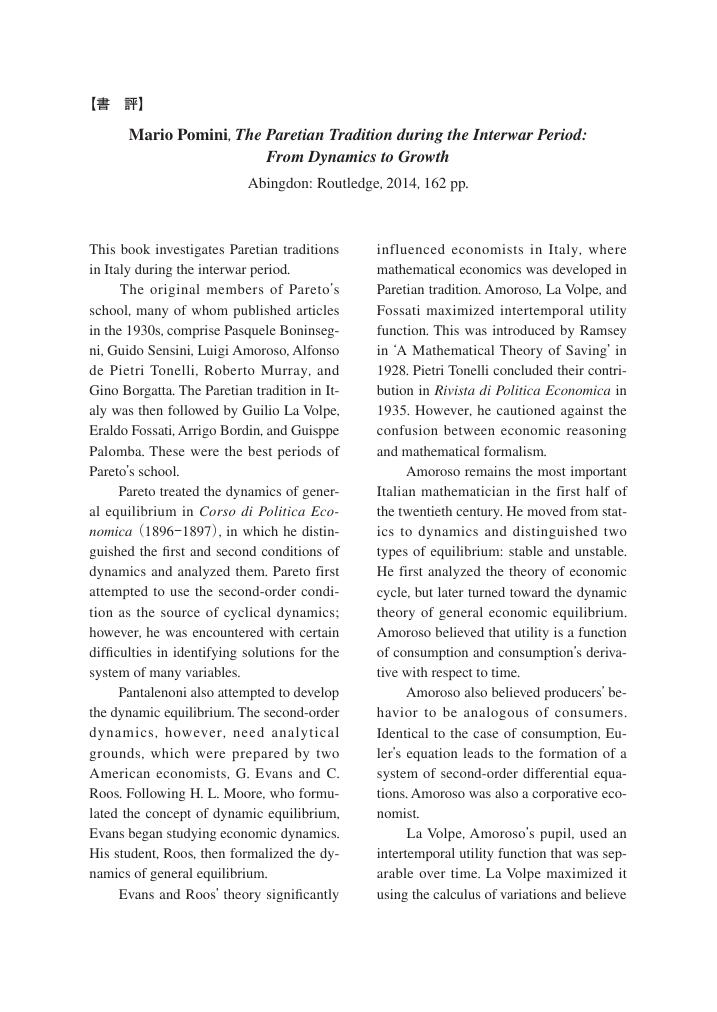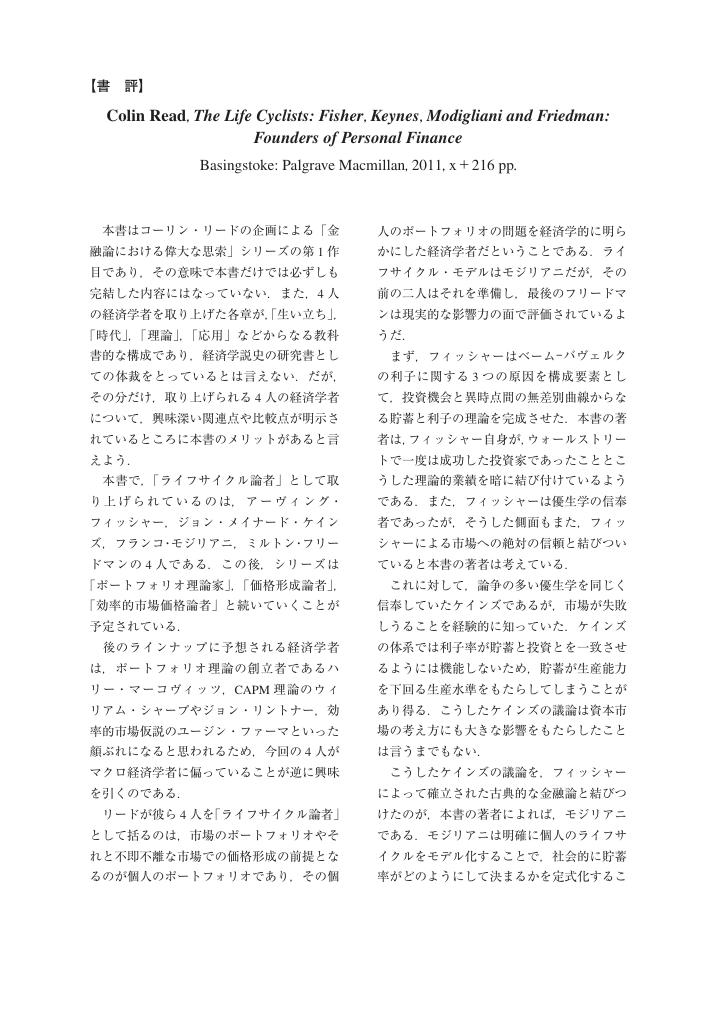47 0 0 0 OA 行政による専門家利用を考える : 宮島鹿保護管理計画を事例に
- 著者
- 山崎 好裕 Yamazaki Yoshihiro
- 出版者
- 福岡大学研究推進部
- 雑誌
- 福岡大学経済学論叢 = Fukuoka University Review of Economics (ISSN:02852772)
- 巻号頁・発行日
- vol.65, no.2, pp.207-227, 2021-03
33 0 0 0 OA 統計的推測の誤用としての奄美大島「ノネコ」生息数推定
- 著者
- 山崎 好裕 Yamazaki Yoshihiro
- 出版者
- 福岡大学研究推進部
- 雑誌
- 福岡大学経済学論叢 = Fukuoka University Review of Economics (ISSN:02852772)
- 巻号頁・発行日
- vol.64, no.2, pp.135-145, 2020-03
5 0 0 0 OA 有効産出と独立投資 : 下村治の動学理論
- 著者
- 崔 艶娜 山崎 好裕 Cui Yan-Na Yamazaki Yoshihiro
- 出版者
- 福岡大学研究推進部
- 雑誌
- 福岡大学経済学論叢 = Fukuoka University Review of Economics (ISSN:02852772)
- 巻号頁・発行日
- vol.59, no.1-2-3-4, pp.41-51, 2015-03
4 0 0 0 OA 量子力学の確率と現代マクロ経済学の確率
- 著者
- 山崎 好裕 Yamazaki Yoshihiro
- 出版者
- 福岡大学研究推進部
- 雑誌
- 福岡大学経済学論叢 = Fukuoka University Review of Economics (ISSN:02852772)
- 巻号頁・発行日
- vol.62, no.1-2, pp.19-22, 2018-03
2 0 0 0 IR 最低賃金制度と経済成長 : 内生的貨幣供給理論に基づく分析
- 著者
- 丁 遠一 山崎 好裕
- 出版者
- 福岡大学
- 雑誌
- 福岡大学経済学論叢 (ISSN:02852772)
- 巻号頁・発行日
- vol.54, no.3, pp.257-274, 2010-03
1 0 0 0 OA 江戸のMMT : 福岡藩天保の改革と白水養禎
- 著者
- 山崎 好裕 Yamazaki Yoshihiro
- 出版者
- 福岡大学研究推進部
- 雑誌
- 福岡大学経済学論叢 = Fukuoka University Review of Economics (ISSN:02852772)
- 巻号頁・発行日
- vol.66, no.2, pp.127-139, 2022-03
1 0 0 0 OA 反転するユートピア「アトランティス」 : 新大陸と近代科学文明の成立
- 著者
- 山崎 好裕 Yamazaki Yoshihiro
- 出版者
- 福岡大学研究推進部
- 雑誌
- 福岡大学経済学論叢 = Fukuoka University Review of Economics (ISSN:02852772)
- 巻号頁・発行日
- vol.65, no.2, pp.193-205, 2021-03
1 0 0 0 OA テンソルはなぜ経済学に用いられなかったのか?
- 著者
- 山崎 好裕 Yamazaki Yoshihiro
- 出版者
- 福岡大学研究推進部
- 雑誌
- 福岡大学経済学論叢 = Fukuoka University Review of Economics (ISSN:02852772)
- 巻号頁・発行日
- vol.63, no.1, pp.107-115, 2018-09
1 0 0 0 OA ケインズと精神医学
- 著者
- 山崎 好裕
- 出版者
- 経済学史学会
- 雑誌
- 経済学史研究 (ISSN:18803164)
- 巻号頁・発行日
- vol.60, no.2, pp.106-110, 2019 (Released:2019-09-04)
- 著者
- 山崎 好裕
- 出版者
- The Japanease Society for the History of Economic Thought
- 雑誌
- 経済学史研究 (ISSN:18803164)
- 巻号頁・発行日
- vol.57, no.2, pp.124-125, 2016 (Released:2019-11-26)
- 著者
- 山崎 好裕
- 出版者
- 経済学史学会
- 雑誌
- 経済学史研究 (ISSN:18803164)
- 巻号頁・発行日
- vol.56, no.1, pp.129-130, 2014 (Released:2019-08-24)
- 著者
- 山崎 好裕
- 出版者
- 経済学史学会
- 雑誌
- 経済学史研究 (ISSN:18803164)
- 巻号頁・発行日
- vol.55, no.1, pp.114-115, 2013 (Released:2019-11-27)
1 0 0 0 OA ルーカスの始原から マクロ合理的期待モデルの誕生と屈折するシカゴ
- 著者
- 山崎 好裕
- 出版者
- 経済学史学会
- 雑誌
- 経済学史研究 (ISSN:18803164)
- 巻号頁・発行日
- vol.54, no.2, pp.11-29, 2012 (Released:2019-08-22)
This paper focuses on three papers by Lucas in his early career as a macroeconomist. Consider-ing Lucas and Rapping (1969), Lucas and Pres-cott (1970), and Lucas (1972) successively, we found that Lucasʼs first macro rational expecta-tion model was built combining his macroeco-nomic interest in labor supply and smart mathe-matical techniques to treat a stochastic process and probability. The former had arisen through research from a Keynesian perspective. The latter was the result of research on the investment function, which was parallel to Tobinʼs q theory. We can therefore conclude that Lucasʼs econom-ics was born in a more Keynesian context than has ever been thought. This historical aspect has been virtually neglected by those who thought much of ideological slogans of the macro ration-al expectation school. Lucas (1972), which pro-vided the first macro rational expectation model, was too complicated in terms of structure. Be-sides its very structure, however, it is more important to point out that Lucas introduced to modern macroeconomic theory the concept that stochastic shocks are the main causal factors of economic fluctuations. This revived the lost leg-acy in the early history of econometric research. Lucasʼs economics turns out to have a very interesting feature from this point of view. Though it always retains general equilibrium as the reference axis, it tends to escape from the equilibrium strongly determined by the excess power of the economy. When Lucas built an endogenous growth model, he added an external effect term to Uzawaʼs production function. Such a com-pound feature of Lucasʼs economics made the Chicago school more comprehensive and truly the mainstream of contemporary macroeconom-ics. JEL classification numbers: B 22, E 13.
1 0 0 0 OA More than an Economic Theory:
- 著者
- 山崎 好裕
- 出版者
- The Japanease Society for the History of Economic Thought
- 雑誌
- 経済学史研究 (ISSN:18803164)
- 巻号頁・発行日
- vol.52, no.2, pp.131-137, 2011 (Released:2019-08-20)
- 著者
- 山崎 好裕
- 出版者
- The Japanease Society for the History of Economic Thought
- 雑誌
- 経済学史研究 (ISSN:18803164)
- 巻号頁・発行日
- vol.48, no.1, pp.177-179, 2006-06-30 (Released:2010-08-05)
1 0 0 0 OA 成長と循環の融合
- 著者
- 山崎 好裕
- 出版者
- The Japanease Society for the History of Economic Thought
- 雑誌
- 経済学史研究 (ISSN:18803164)
- 巻号頁・発行日
- vol.48, no.1, pp.110-123, 2006-06-30 (Released:2010-08-05)
- 参考文献数
- 39
Most historians of economics so far have regarded the history of macroeconomics as a process of rivalry among schools or paradigms. In the usual approach, they have attempted to describe it by establishing clear differences between one school and another. A commonly accepted view of history, therefore, is the story of the Keynesian revolution and the anti-Keynesian counter-revolution. We now understand, however, that this familiar approach cannot completely account for the heterogeneity in American Keynesian and the divergence in neoclassical macroeconomics.This paper proposes an alternative view of the history of macroeconomics. Keynes did not create the field of macroeconomic theory; he simply transformed the structural emphases of a field of study that had existed since before his arrival as an economist. Keynes overemphasized short-term fluctuations of economy or business cycles, and that accidental event in the history of the field had the effect of separating two viewpoints and macroeconomists swung heavily to one side.The apparently lost viewpoint of growth, however, was revived beneath the surface of the cycle view, gathering steam and then giving birth first to the neoclassical theory of growth and soon thereafter to the optimal growth theory. Following a period of ferment and confusion, what is called real-business cycle theory integrated the two viewpoints. Their reintegration was not simply a return to the old framework but was part of the serious process being undertaken by researchers endeavoring to build optimal dynamic models more completely.In the minds of macroeconomists, the conflict among schools is now a thing of the past. In this paper I argue that we historians of economics must also change our perspec tive as we describe our histories of macroeconomics. Our thinking should be oriented toward integration and fusion instead of divergence and alternation.
- 著者
- 山崎 好裕
- 出版者
- The Japanese Society for the History of Economic Thought
- 雑誌
- 経済学史学会年報 (ISSN:04534786)
- 巻号頁・発行日
- vol.45, no.45, pp.131-133, 2004 (Released:2010-08-05)
- 著者
- 山崎 好裕
- 出版者
- The Japanese Society for the History of Economic Thought
- 雑誌
- 経済学史学会年報 (ISSN:04534786)
- 巻号頁・発行日
- vol.36, no.36, pp.177-178, 1998 (Released:2010-08-05)
- 著者
- 山崎 好裕
- 出版者
- The Japanese Society for the History of Economic Thought
- 雑誌
- 経済学史学会年報 (ISSN:04534786)
- 巻号頁・発行日
- vol.33, no.33, pp.113-121, 1995 (Released:2010-08-05)
In this paper, we consider the influence of econometrics as a tool on macroeconomics as a vision focusing on the disturbance term in econometric and theoretical models.Keynes rejected Tinbergen's method. The reason is that Keynes's views on probability conflicted with the concept of probability expressed in the disturbance term of Tinbergen's model.In macroeconometrics the disturbance term was interpreted as the influence of omitted variables and was viewed as caused by measurement error at the earlier stage and by sampling error at the later one.After the attack on Keynesian theory and simultaneous equation models by the rational expectations school and by proponents of vector autoregressive models, a disturbance term came to be introduced into theoretical models. They are interpreted as shocks caused by a shortage of information or by a fluctuations of productivity.
1 0 0 0 OA 商店街スタンプと需要の価格弾力性
- 著者
- 山崎 好裕 Yamazaki Yoshihiro
- 出版者
- 福岡大学研究推進部
- 雑誌
- 福岡大学経済学論叢 = Fukuoka University Review of Economics (ISSN:02852772)
- 巻号頁・発行日
- vol.64, no.1, pp.39-44, 2019-09







